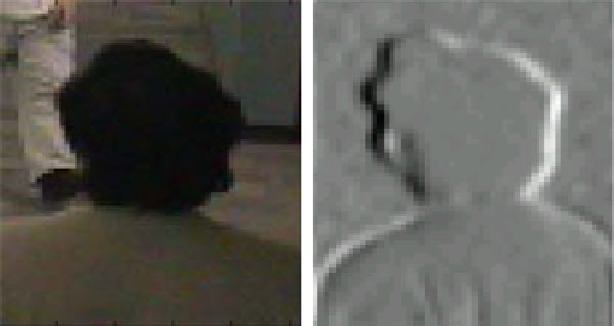Database Reference
In-Depth Information
Fig. 7.11
A training sample and its gradient for the construction of the HOG model for the
characterization of shape information of a human's head and shoulder
⊧
⊨
0
K
p
∈
O
R
p
(
B
)=
(7.24)
p
∈
B
⊩
P
(
O
p
)
p
∈
O
∪
B
where
O
and
B
denote the subsets of pixels a priori known to be a part of “object”
and “background”, correspondingly. The subsets
O
ↂ
P
and
B
ↂ
P
are such that
O
∩
B
=
0. In addition,
∑
K
=
1
+
max
p
B
(
p
,
q
)
(7.25)
∈
P
q
:
{
p
,
q
}∈
N
In the experiment, a HOG model is trained by a collection of human head and
shoulders as shown in Fig.
7.11
. With the prior of a shape of a head, when the same
algorithm is run on Akiyo shown in Fig.
7.12
, it improves the segmentation results
because of the preference for the overall shape of a human. In Fig.
7.12
b, the Akiyo
sequence shows positive response to the HOG filter near the center of the frame,
increasing the likelihood that there is an object of interest there.
The additional results from video object segmentations are shown in Figs.
7.13
,
7.14
,
7.15
and
7.16
. The user marked the objects at Frame no. 1, and the system
performed segmentation through the following frames. The results at Frame no. 10
are shown in the figures. It was observed that the system's performance was satisfy
and after final user marking, perfect segmented results could be attained. In the bus
sequence (Fig.
7.13
), the algorithm was robust enough to track the bus object thru
the lamppost at the left side of the video. As the bus passed thru the lamppost, it was
occluded and split into two separate objects. The algorithm still can segment the bus,
but the frontal white edge of the bus is lost. A simple marking of the bus in Fig.
7.13
a
allows the bus to be segmented correctly. Other segmented objects in the images are

Search WWH ::

Custom Search